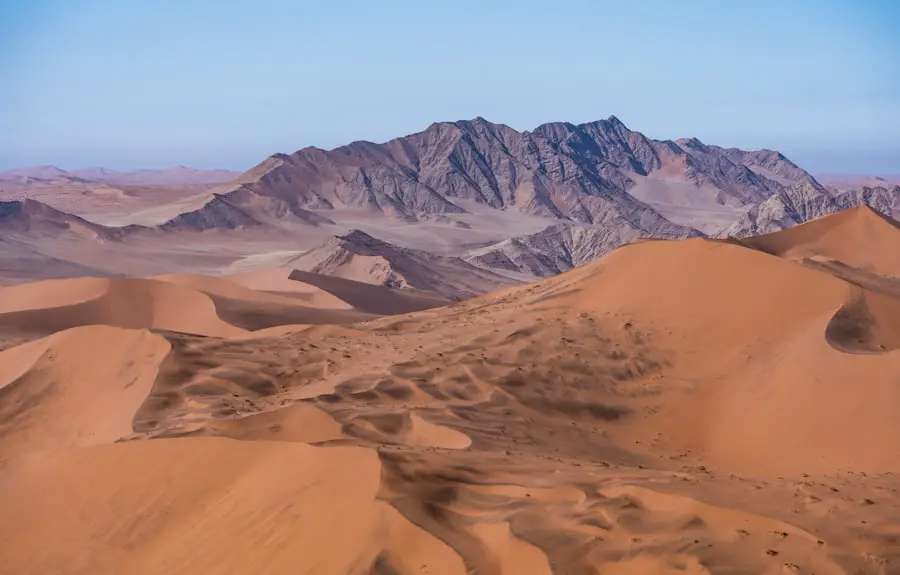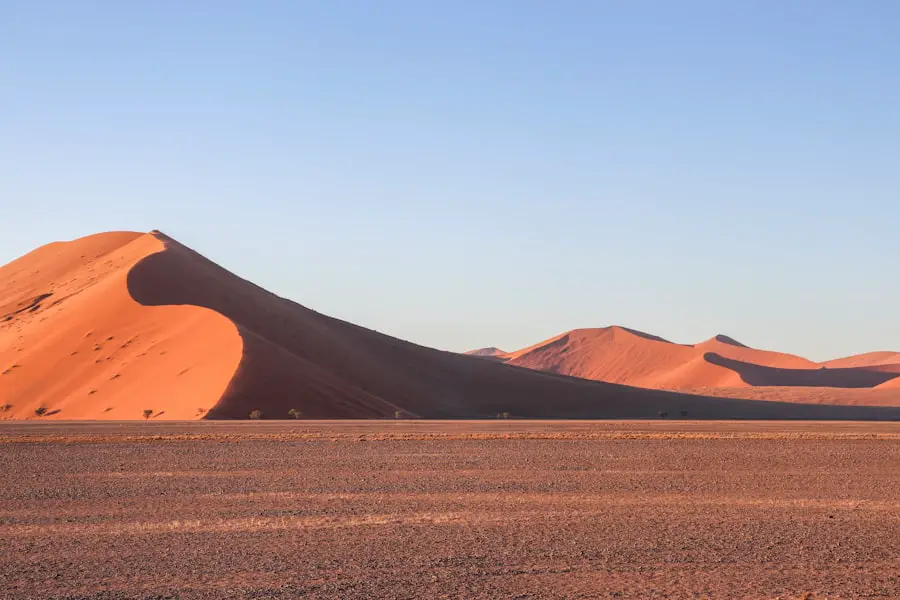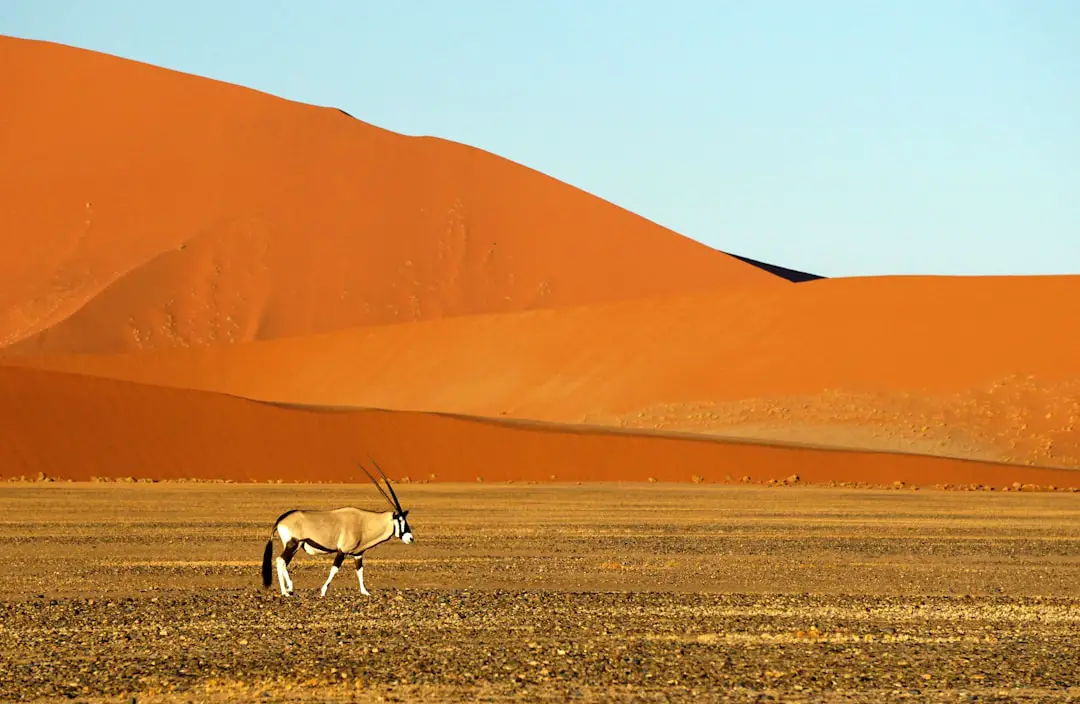Namibia is characterized by a diverse climate that varies significantly across its vast landscapes, influenced by its geographical features and topography. The country experiences a predominantly arid climate, with the Namib Desert along the coast and the Kalahari Desert in the east. The coastal regions are moderated by the cold Benguela Current, which results in cooler temperatures and fog, particularly in the mornings.
In contrast, the interior regions can experience extreme temperature fluctuations, with scorching heat during the day and cooler nights. The central plateau, where cities like Windhoek are located, enjoys a semi-arid climate, with summer rainfall typically occurring between November and March. The seasonal variations in Namibia’s climate are marked by two main seasons: the dry season and the wet season.
The dry season, which spans from May to October, is characterized by clear skies, low humidity, and minimal rainfall. This period is particularly appealing to tourists as it offers excellent visibility for wildlife viewing and outdoor activities. Conversely, the wet season brings higher temperatures and sporadic rain showers, transforming the landscape into a lush green paradise.
However, this season also presents challenges such as muddy roads and limited access to certain areas, which can affect travel plans.
Key Takeaways
- Namibia has a dry climate with very little rainfall, making it a great year-round destination for travelers.
- The peak tourist season in Namibia is during the dry winter months from May to October, when wildlife viewing is at its best.
- The off-peak season in Namibia is during the hot summer months from November to April, offering lower prices and fewer crowds.
- The best time for wildlife viewing in Namibia is during the dry winter months when animals gather around water sources.
- The ideal weather for outdoor activities in Namibia is during the cooler winter months, when temperatures are more comfortable for hiking and exploring.
- Special events and festivals in Namibia, such as the Windhoek Carnival and the Caprivi Cultural Festival, take place throughout the year and offer unique cultural experiences for travelers.
- Budget travelers should consider visiting Namibia during the off-peak season for lower prices on accommodations and activities.
- Travelers visiting Namibia during the shoulder season should be prepared for fluctuating weather and potential closures of certain attractions.
Peak Tourist Season in Namibia
The peak tourist season in Namibia typically occurs during the dry months from May to October. This period coincides with the southern hemisphere’s winter, when temperatures are more moderate and wildlife congregates around dwindling water sources. As a result, national parks such as Etosha National Park become bustling hubs for wildlife enthusiasts eager to witness the spectacular array of animals that inhabit the region.
Visitors flock to see elephants, lions, giraffes, and various antelope species, all of which are more easily spotted during this time due to the sparse vegetation. Accommodations and tour operators often experience high demand during the peak season, leading to increased prices and limited availability. Travelers planning to visit during this time should book their accommodations well in advance to secure their preferred lodgings.
Additionally, guided tours and safari experiences can fill up quickly, making early reservations essential for those looking to explore Namibia’s stunning landscapes and rich biodiversity. The vibrant atmosphere during peak season is palpable, with travelers from around the globe sharing their experiences and marveling at the natural beauty that Namibia has to offer.
Off-Peak Season in Namibia

The off-peak season in Namibia generally spans from November to April, coinciding with the wet season. During this time, the country experiences higher humidity and occasional rain showers, particularly in January and February. While some may view this as a less desirable time to visit due to potential travel disruptions caused by muddy roads and unpredictable weather, there are distinct advantages to traveling during this period.
For one, the landscapes come alive with vibrant greenery and blooming flora, creating a picturesque backdrop for photography enthusiasts. Moreover, visiting during the off-peak season often means fewer crowds at popular tourist destinations. This allows for a more intimate experience with nature and wildlife, as travelers can enjoy serene moments without the hustle and bustle of peak season tourists.
Additionally, many lodges and tour operators offer discounted rates during this time to attract visitors, making it an appealing option for budget-conscious travelers. While wildlife may be more dispersed due to the availability of water sources, keen observers can still spot various species in their natural habitats.
Best Time for Wildlife Viewing
| Location | Best Time for Wildlife Viewing |
|---|---|
| Yellowstone National Park | Spring and Fall |
| Maasai Mara, Kenya | July to October |
| Galapagos Islands | Year-round |
| Great Barrier Reef, Australia | June to November |
When it comes to wildlife viewing in Namibia, the dry season from May to October is widely regarded as the best time for such activities. As water sources become scarce during these months, animals congregate around waterholes, making them easier to spot. Etosha National Park is particularly renowned for its exceptional wildlife viewing opportunities during this period.
Visitors can witness large herds of elephants and buffaloes gathering at waterholes while predators like lions and leopards lie in wait nearby. In addition to Etosha, other regions such as the Caprivi Strip (now known as Zambezi Region) also offer excellent wildlife viewing opportunities during the dry season. The lush vegetation that flourishes during the wet months provides ample cover for animals, making them harder to spot.
However, as the dry season progresses and vegetation thins out, wildlife becomes more visible against the arid backdrop. Birdwatchers will also find this time particularly rewarding, as migratory birds flock to Namibia’s wetlands before returning south for breeding.
Ideal Weather for Outdoor Activities
Outdoor enthusiasts will find that Namibia’s dry season offers ideal weather conditions for a variety of activities such as hiking, camping, and exploring national parks. The cooler temperatures during this time make it comfortable for long hikes through iconic landscapes like the Fish River Canyon or Sossusvlei’s towering sand dunes. The clear skies provide excellent visibility for photography, allowing travelers to capture breathtaking sunrises and sunsets over Namibia’s diverse terrains.
In contrast, the wet season can present challenges for outdoor activities due to increased humidity and occasional rain showers. While some may enjoy the lush scenery that comes with the rains, others may find it less conducive for hiking or camping due to muddy trails and potential flooding in low-lying areas. However, adventurous travelers who embrace the off-peak season can still partake in unique experiences such as exploring waterfalls or witnessing dramatic thunderstorms over the landscape.
Special Events and Festivals

Namibia hosts a variety of special events and festivals throughout the year that showcase its rich cultural heritage and vibrant traditions. One notable event is the Windhoek Carnival held annually in March or April. This lively celebration features colorful parades, traditional music, dance performances, and local cuisine that reflect Namibia’s diverse cultures.
It attracts both locals and tourists alike who come together to celebrate unity and cultural diversity. Another significant event is the Namibian Independence Day celebrated on March 21st each year. This national holiday commemorates Namibia’s independence from South African rule in 1990 and is marked by various festivities across the country.
Parades, speeches by political leaders, cultural performances, and community gatherings take place in cities like Windhoek and Swakopmund. For travelers seeking an authentic cultural experience, participating in these events provides insight into Namibia’s history and traditions while fostering connections with local communities.
Considerations for Budget Travelers
For budget travelers looking to explore Namibia without breaking the bank, there are several considerations to keep in mind when planning their trip. Traveling during the off-peak season can lead to significant savings on accommodations and activities as many lodges offer discounted rates to attract visitors during quieter months. Additionally, opting for self-catering accommodations or camping can further reduce costs while allowing travelers to immerse themselves in nature.
Public transportation options such as buses or shared taxis can also be a cost-effective way to navigate between cities and attractions. While renting a vehicle provides greater flexibility for exploring remote areas at one’s own pace, it can be more expensive when factoring in fuel costs and insurance. Budget travelers should also consider visiting national parks that have lower entrance fees or exploring lesser-known destinations that offer unique experiences without the crowds typically found at popular sites.
Tips for Traveling During the Shoulder Season
Traveling during Namibia’s shoulder season—typically from late April to early May or late October to early November—can offer a balanced experience between peak and off-peak seasons. During these transitional months, travelers can enjoy milder weather conditions while avoiding some of the crowds associated with peak tourist times. To make the most of this period, it is advisable to pack layers of clothing to accommodate fluctuating temperatures throughout the day.
Additionally, travelers should remain flexible with their itineraries as weather conditions can be unpredictable during shoulder seasons. While rain may still occur in late April or early November, it often does not last long enough to disrupt travel plans significantly. Engaging with local tour operators who have experience navigating these transitional months can provide valuable insights into optimal routes and activities based on current conditions.
In conclusion, understanding Namibia’s climate and seasonal variations is crucial for planning an enjoyable visit to this stunning country. Whether one chooses to travel during peak or off-peak seasons or seeks unique experiences through special events or budget-friendly options, Namibia offers a wealth of opportunities for exploration and adventure throughout the year.
When planning your trip to Namibia, it’s important to consider the best time to visit this stunning destination. According to TakeTravelInfo, the ideal time to travel to Namibia is during the dry season, which typically falls between May and October. During this time, you can expect clear skies, warm temperatures, and excellent wildlife viewing opportunities. Be sure to pack some waterproof sneakers for your adventures in Namibia’s diverse landscapes. And don’t forget to check out the best travel camera backpack and carry-on luggage for international travel to ensure you’re well-prepared for your journey.
FAQs
What is the best time to travel to Namibia?
The best time to travel to Namibia is during the dry season, which runs from May to October. This is when the weather is cooler and there is less rainfall, making it ideal for wildlife viewing and outdoor activities.
What is the weather like in Namibia during the best time to travel?
During the dry season, Namibia experiences clear skies, sunny days, and cooler temperatures. Daytime temperatures range from 20°C to 30°C (68°F to 86°F), while nighttime temperatures can drop to around 5°C to 10°C (41°F to 50°F).
What are the popular attractions to visit in Namibia during the best time to travel?
Popular attractions to visit in Namibia during the dry season include Etosha National Park for wildlife viewing, Sossusvlei for its iconic red sand dunes, and the coastal town of Swakopmund for outdoor activities such as sandboarding and quad biking.
Are there any specific events or festivals to attend during the best time to travel to Namibia?
During the dry season, Namibia hosts the Windhoek Annual Cultural Festival, which showcases traditional music, dance, and food from various Namibian ethnic groups. Additionally, the Namibian Tourism Expo takes place in June, featuring exhibitions and activities related to travel and tourism in Namibia.
What should I pack for a trip to Namibia during the best time to travel?
When traveling to Namibia during the dry season, it is recommended to pack lightweight and breathable clothing for warm daytime temperatures, as well as layers for cooler evenings. Additionally, sun protection such as hats, sunglasses, and sunscreen is essential, along with sturdy walking shoes for outdoor activities.
